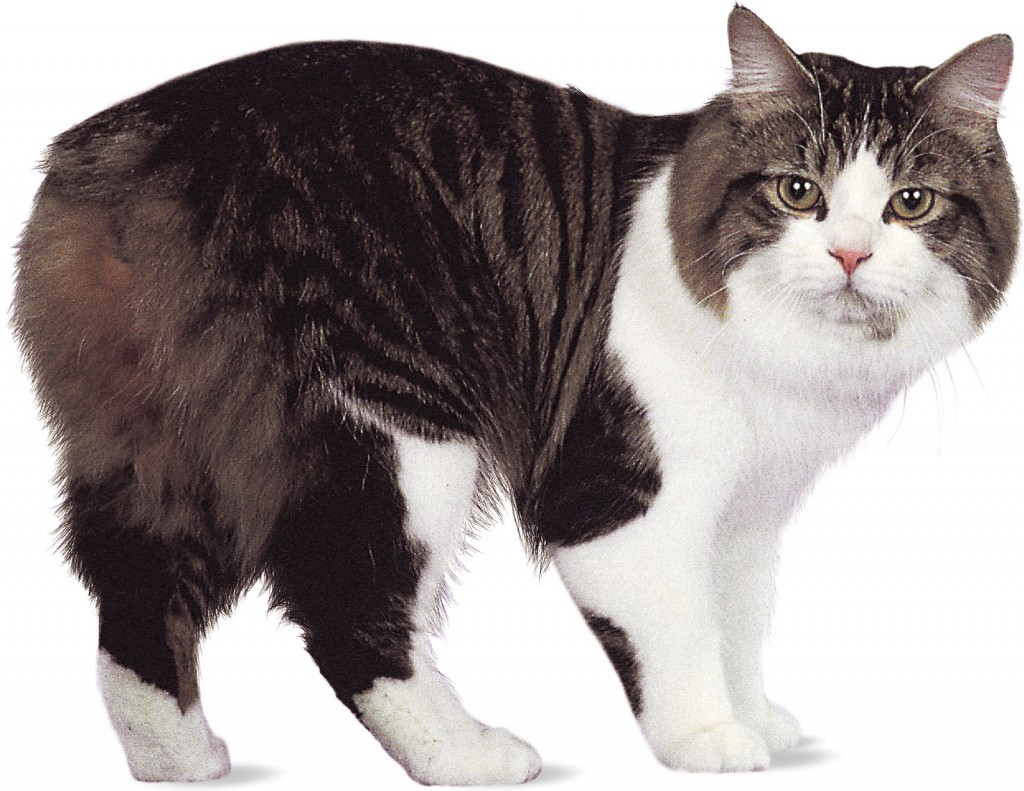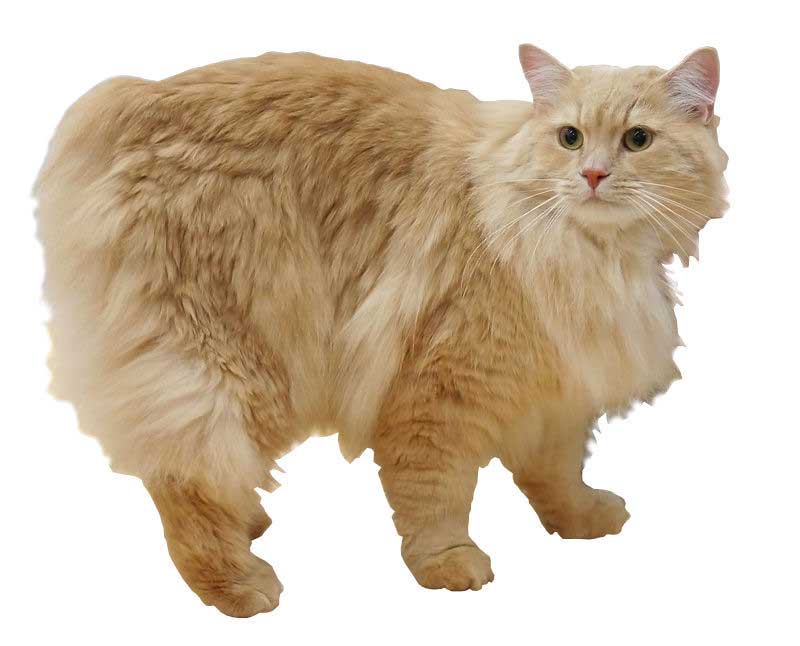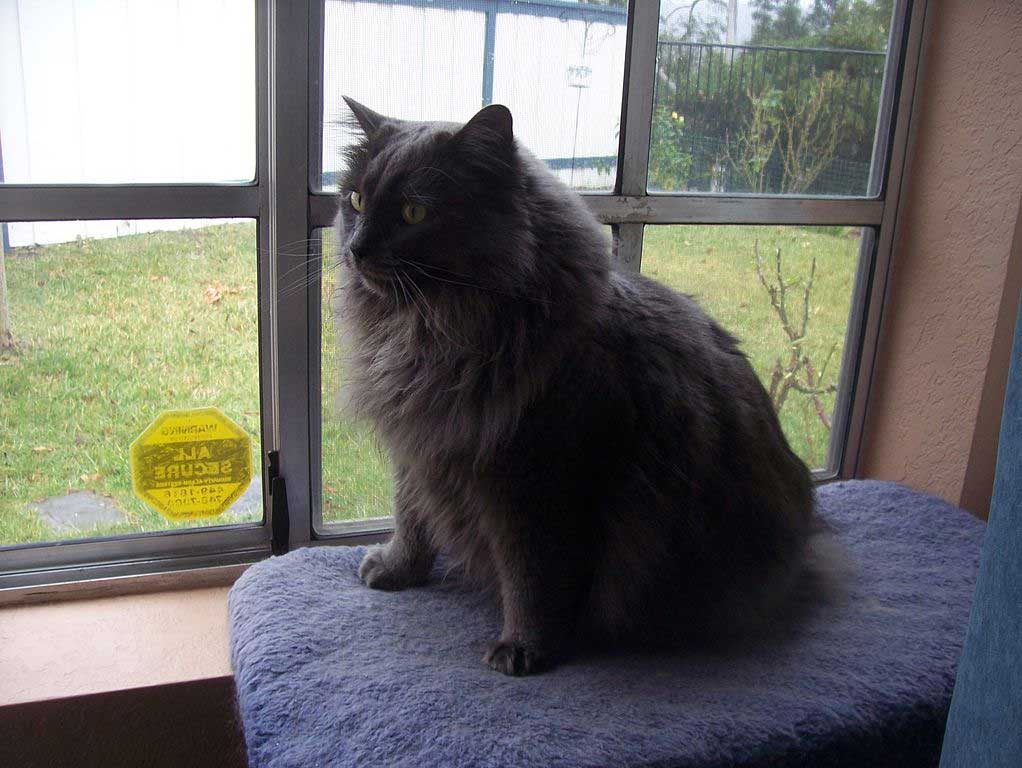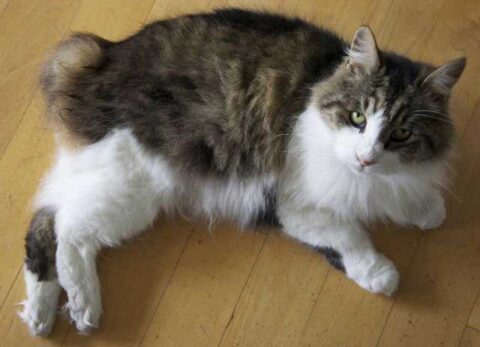
Content |
|---|
Characteristics "Cymric cat"
Coexistence is important that you have with your new friend. Before considering the acquisition of a cat of the breed "Cymric cat" you know certain factors. You must take into account their character, their need for exercise, their interaction with other pets, their care and if you have small children, their level of tolerance towards them.
Joy3.0 out of 5 stars (based on 1 review)
|
Activity level3.0 out of 5 stars (based on 1 review)
|
Friendliness to other pets5.0 out of 5 stars (based on 1 review)
|
|---|---|---|
Friendliness to children5.0 out of 5 stars (based on 1 review)
|
Grooming requirements3.0 out of 5 stars (based on 1 review)
|
Vocality2.0 out of 5 stars (based on 1 review)
|
Need for attention3.0 out of 5 stars (based on 1 review)
|
Affection towards its owners4.0 out of 5 stars (based on 1 review)
|
Docility4.0 out of 5 stars (based on 1 review)
|
Intelligence4.0 out of 5 stars (based on 1 review)
|
Independence3.0 out of 5 stars (based on 1 review)
|
Hardiness1.0 out of 5 stars (based on 1 review)
|
History
The Cymric cat hails from the Isle of Man, located in the Irish Sea, between Ireland and the United Kingdom. It takes its name from the Welsh word “Wales”, that means “Wales”. It's a long-haired version of the Manx cat, so talk about the history of Cymric is also talking about the history of Manx, since both are largely intertwined.
The cat is believed to have originated around the decade of 1750, but there are many different versions of how your ancestors came to the island. They could have crossed the sea with the Spanish Armada in the 1980s. 1580, the Vikings who settled on the island around the year 800, or even long before, with the Phoenician merchants, around the year 500 a.C.
The history of the Cymric and that of the Manx It, Therefore, quite vague, but it is also full of stories. In particular, various legends try to explain how this cat lost its tail. One of them tells that he arrived too late at Noah's Ark and that the door closed on his tail. Another says that the Vikings used to steal kittens because their tails were considered lucky.; as a result, mother cats bit the tails of their pups so as not to lose them. Another explanation is that the islanders used to cut the tails of their cats during the harsh winters to save firewood.. In effect, a cat without a tail enters the house faster, allowing the door to be closed earlier.
From a more scientific point of view, the fact that Manx cats and Cymric cats be anura (that is to say, have their tail docked) It is explained by a spontaneous genetic mutation that was reinforced by centuries of inbreeding due to the insular nature of the breed. This corresponds to an incomplete formation of the spine., and the gene responsible for this is called gene Manx, since it was first observed in this cat. According to some archival documents, this particularity, commonly called “syndrome of Manx“, began to be observed on the island, so many specialists deduce that cats without a tail were born in these lands. Other, on the other hand, they are convinced that a cat with this peculiarity was brought from abroad via a ship, and spread his gene to the island's feline population. It must be said that the gene Manx is dominant, which greatly facilitates its dissemination: in effect, it is enough that only one of the two parents is a carrier, and thus present this anatomical specificity, so that a part of your kittens is in the same case.
Exists in all vertebrate mammals, and therefore notably in cats of other breeds. Having said that, although within these breeds you can find short-tailed and tailless cats - due to the same genetic mutation- the Cymric and the Manx They are the only breeds that do not specifically have a tail..
Parallel to the absence of a tail, during the years 1940-1950 a recessive gene that gave long hair was introduced into the lines. But, this feature was initially considered a defect, to the point that all the individuals that presented it were excluded from breeding and exhibition. It wasn't until a decade later, over the years 60, when Canadian breeders began to take an interest in this trait and established it as a characteristic of the Cymric.
This led to the differentiation between the Manx cat (shorthair) and the Cymric cat (longhair). Breeding programs dedicated entirely to the latter began in Canada., which allowed its recognition by the Canadian Cat Association (CCA) in 1970. The breed was also introduced to the United States, where it was very well received and quickly gained popularity. Breeders considered to be the pioneers of the breed are both Canadians and Americans. Blair Wright y Leslie Falteisek, in particular, were responsible for the current name of the breed: until then it was known simply as Manx longhair, but the name was changed to Cymric in the decade of 1970. This illustrates the clear differentiation between the Manx and the Cymric that was introduced at that time, when the latter began to be considered a breed in its own right. In other words, although they are of British origin, It was in North America where the Cymric became independent and took off.

Following its recognition by the CEC in 1970, it was the turn of the TICA (The International Cat Association) in 1979.
The Cat Fan Association (CFA), which had recognized the Manx since its founding in 1906, did the same, recognizing the Cymric as a race in its own right in 1989. But, the CFA reversed its position only five years later, in 1994, arguing that the Cymric should be considered a variety of Manx cat and not a race in its own right. Then it started to call Manx longhair, as opposed to Manx shorthair , considering both as two varieties of the same race and having the same standard. The main argument for the association was the strong resemblance between the two cats, that only differ by the length of the hair.
In fact, the resemblance is such that in most associations that consider the two breeds separately, parents kittens Manx but with long hair they are recorded as Cymrics.
The Governing Council of the Cat Fancy (GCCF) also consider the Cymric as a simple variety of the Manx cat. Last, the Fédération Internationale Féline (FIFé), covering some forty countries, including France and Belgium, and that he had recognized Manx in 1949, lined up on 2006 with the position of the TICA, also considering the Cymric cat as a race in its own right.
In France, despite its recognition as a breed in its own right, the Cymric cat it's almost impossible to find: only one individual was registered in the Livre Officiel des Origines Félines between 2003 and 2019.
In countries where it is considered a simple variety of the Manx cat, it is more difficult to measure its popularity, since it remains “drowned” in the statistics of the latter. But, It should be noted that in the United States, the Manx cat stands just above the position 30 (of little more than 40) in the breed classification based on the number of annual entries in the CFA, that is to say, is far from widespread, and this is even more true for his long-haired variant. The situation in the UK is similar to that in France: it can be considered that the Cymric cat is almost absent from the country, since the number of Manx registered annually was about 40 around the decade of 2000, and then collapsed from 2007, to the point where you can now count on the fingers of one hand. But, in 2018 there was a jump to more than 22 registrations, but it remains to be seen if this recovery will be sustainable.
Physical characteristics
The Cymric It's a long-haired version of the Manx cat: apart from coat length, the two races are identical. The Cymric it is a medium size cat, of solid bones, lighter than it seems and distinguished by its rounded appearance, from the eyes to the spine, head and body in general.
Its back short and compact forms an arch. The legs they are strong and the front ones are shorter than the rear ones. The thighs are especially muscular and the general appearance of the four limbs is such that some compare it to a rabbit. The feet They are round, medium in size and quite bushy.
The head is rounded and slightly longer than wide. It has the ears widely separated with rounded tips. The cheeks are prominent and the muzzle is longer than it is wide. The eyes they are big, round and can be yellow, orange, hazelnut or greens.
The main distinguishing feature of the Cymric and of the Manx is the no tail. It is the result of a spontaneous genetic mutation quite common in cats., and is called “manx syndrome“, even when it occurs in individuals of other races. But, it is possible that Cymrics and Manx are born with a longer or shorter tail. Some have up to three sacral vertebrae (vertebrae located in the pelvic region): called “risers“. Other, the “stumpies“, have a stump composed of one to three caudal vertebrae (vertebrae located in the tail). Last, the “longys” have a tail longer than a stump, but shorter than that of the other races.
Individuals that do not have a tail -the most common case- are called “rumpies“. Only rumpies and risers are accepted in cat shows, but the other types are still of great value to the breed and are found in most breeding programs, since the breeding of two completely tailless individuals causes the death of a quarter of the fetuses before birth, and spinal malformations (calls “manx syndrome“) in around the 20% of those who are born, which leads to certain death to 3/4 years.
But, It should be noted that for cats that get rid of these serious problems, the absence of a tail -which is the lot of most representatives of the breed- not really a disadvantage: as he Cymric as the Manx they have little to envy their peers in terms of their sense of balance, since they have known how to adapt to the absence of it.
Its fur it's semi-long, thick, silky and double-layered. The breed offers a wide range of coat colors: brown, carey, cream, blue, Silver, black, red, white… There is also diversity in terms of coat patterns: ombre, smoked, striped, calico or tortoiseshell. Chocolate patterns, lavender and Himalayas are not allowed in the breed standard. It also, the coat may change color and / or length with the seasons, becoming lighter in summer and longer in winter.
Some Cymrics have especially prominent tufts of hair on their ears and legs, a trait that is valued and sought after by breeders and in shows. Even without this feature, the hair is longer on the neck, the belly, legs and chest.
Last, It should be noted that the Cymric and the Manx they mature very slowly, to the point that some do not reach their maximum size before the 5 years. There is also a slight sexual dimorphism, since the male is usually slightly heavier and larger than the female.
Size and weight
- Size: Of 30 to 35 cm.
- Weight: Of 2 to 5 kg
Varieties of "Cymric cat"
The different feline associations distinguish four varieties of Cymric and Manx, the only difference is the size of the tail:
- Rumpy: the cat has no tail;
- Riser : the tail has a cartilaginous growth of one to three sacral vertebrae (vertebrae of the pelvic region);
- Stumpy : the cat has a small tail that measures 3 to 4 cm., formed by one to three caudal vertebrae (that is to say, located in the queue);
- Longy: the cat has a longer tail than the other varieties, but shorter than other breeds.
The varieties Rumpy and Riser are the most likely to transmit Manx syndrome. The manx syndrome causes the death of the kitten, even before birth or shortly after delivery. So, it is recommended not to breed two representatives of these varieties and, Instead, cross tailless cats with stumpies or longies.

Character and skills
Basically, the Cymric cat differs from Manx cat only in the length of her hair, so some reference organizations consider it a mere variety of the latter. They both have similar personality traits.
The Cymric he is a gentle and affectionate cat, who adores the company of humans and is particularly known for his loyalty to them. They love to follow their owners around the house and participate in all the daily tasks.. Some individuals focus all their love on one person, while others show affection to all family members, including children: its tender and attentive nature makes it a good cat breed choice for children, for whom it is a very good playmate. But, they need a loving and caring family, whose members take time to play and interact with them. So, not recommended for people who are absent often, but it is an ideal cat breed for the elderly.
They are never aggressive, rather they enjoy a generally serene and peaceful lifestyle, but that doesn't mean they are inactive. They love to play, either loading things, crawling into cabinets or opening drawers. Able to play with very little, always find something to do. He is also a very clever and clever cat., able to learn tricks: it is very possible, for example, train him to catch a ball, just like a dog.
This powerful cat is also capable of running very fast and making big jumps.. This means that you can easily reach the high shelves, so objects that must be kept absolutely away from this joker are best kept in tightly closed cupboards.
The Cymric cat is not only physically flexible: is very adaptable and can cope with a change of environment, for example after moving in with your cat or even if it is necessary to transfer it to another family.
It must be said that he likes to meet new people, especially if you are used to all kinds of people, animals and situations from a very young age. Living with other dogs usually goes well, just like living with a dog, especially if it belongs to a breed recommended for cats.
On the other hand, you have to be very careful when it comes to small animals that can be prey for him, like birds, rodents or even fish. In fact, in addition to a great passion for the game, has a well developed hunting instinct. If you live in the same house as this type of animal, it is necessary to get used very early not to attack them. But, it is still preferable to avoid contact with them, so the best option is to avoid coexistence.
By the way, he is a pretty disciplined cat, who accepts limits. He quickly understands if his master forbids him certain things, like rubbing on the couch or scratching in certain places.
On the other hand, the Cymric It is a breed of cat that meows a lot.. This big talker is used to meowing to make himself heard., or simply to communicate with its owner. Some individuals even seem to want to play the role of watchdog., as they tend to growl or be threatening when seeing or hearing unusual things.
Health
The absence of a queue in the Cymric and the Manx, caused by the mutation of a gene called “gen manx“, not always benign. This greatly complicates the reproduction of these cats..

First of all, the embryos that are homozygous for the gene -that is, that inherit the mutation of gen manx of both parents- are destined to die before being born, since your spinal cord is not fully developed. They represent about a quarter of the embryos conceived, so litters are usually small. On a larger plane, the breeding of two tailless cats should be avoided at all costs (variety “Rumpand” or “Riser“), as it increases the risk of getting kittens with deformities.
But, ser Heterozygosity is not enough to be healthy: some of the kittens that are heterozygous they are also heavily affected by deformities of the spine. The spine is usually too short, which can cause movement difficulties, damage to the spinal cord and nerves, or malformations of the urinary or intestinal tract. Most kittens with this problem are identified among the 4 and 6 months of age, mainly by observation. So, before adopting a kitten Cymric or Manx of a breeder, it is advisable to check that the breeder has made sure that the kittens are in full health before putting them up for sale. This particular situation explains why representatives of this breed are usually not available before the 4 months of age, since this guarantees that they do not suffer from these health problems beforehand. The percentage of kittens affected is around 20%, and they are mostly rabones, that is to say, tailless. They are usually euthanized, but if not, do not usually survive more than 3 or 4 years; the oldest cat had 5 years when he died.
This physical characteristic can also cause coccyx arthritis. This affects all varieties, but individuals with a partial tail are most affected.
On the other hand, to a kitten Cymric getting rid of these various risks linked to the absence or unusually short length of its tail is generally promised a long life, since it is not uncommon for representatives of the breed to reach the 20 years of age and living in perfect health. It is a very slow maturing breed, since puppies take many years to reach their adult size, sometimes even 5 years.
One of the health problems they may face is corneal dystrophy, an inherited disease caused by the accumulation of water in the layers of the cornea, which can lead to reduced vision and even blindness.
Last, the Cymric cat are prone to being overweight. So, it is advisable to adapt the portions that are given to your needs (that depend, in particular, of your lifestyle) and check your weight regularly, to prevent any obesity problem in the cat. Although obesity is not a disease in itself, can cause or aggravate various conditions.
Grooming
The long coat of the Cymric cat not particularly difficult to maintain, but must be brushed regularly, ideally two or three times a week. This prevents dead hair from spreading throughout the house. Be more careful during the shedding periods in spring and autumn.
You should also wash your cat's ears about once a week., and do the same with the eyes.
Looking at your nails, largely depends on your level of activity, but natural wear and tear may not be enough: if so, her nails need to be trimmed to prevent embarrassment in her daily life.
Food
The Cymric it is not a particularly difficult cat to feed, and conforms perfectly to quality industrial foods, either croquettes or patés. On the other hand, is very gluttonous and tends to be overweight: therefore, it is advisable to be especially attentive to the amounts of food that are given, and adapt them well according to their physical activity and, Therefore, of your needs. Unlike many races, permanent access to food is not possible, since it is not capable of self-regulation.
For sale "Cymric cat"
The price of a kitten Cymric heavily dependent on his lineage and the reputation of the kennel from which he came. The price range is quite wide, of 900 to 1500 EUR. In any case, the fact that it is a rare breed of cat largely explains its high price. Due to the small number of breeders of Cymric, it is common to have to join a waiting list before being able to take in a kitten of this breed.
Alternative names:
Long-haired Manx / Longhair Manx / Manx Longhair
Videos "Cymric cat"
|
Winston the Cymric Manx
|
Cymric kitten Miyako
|
|---|
